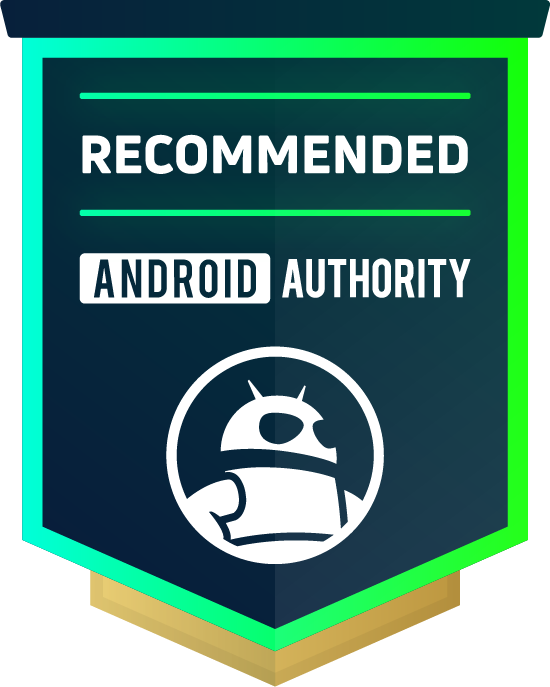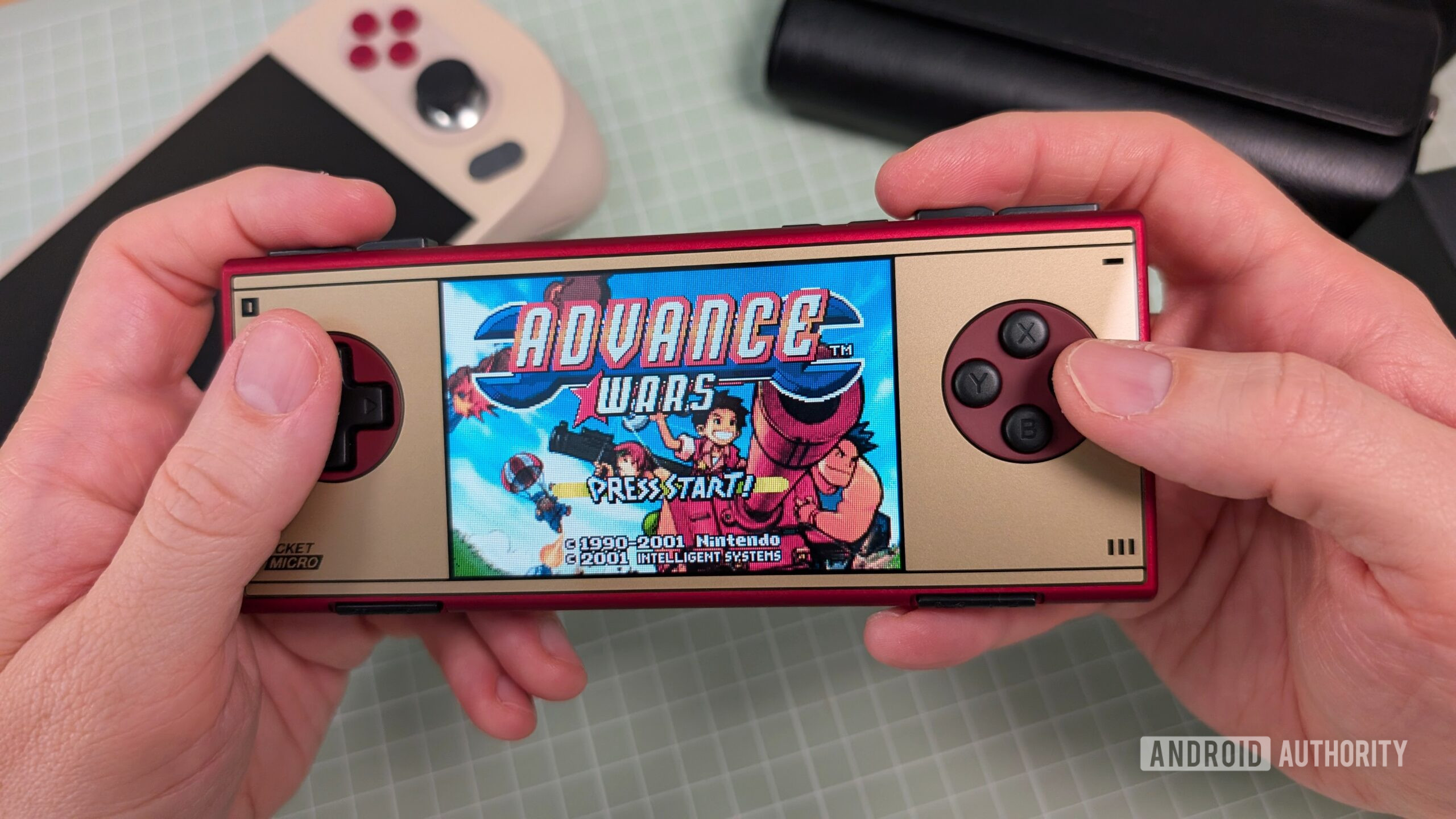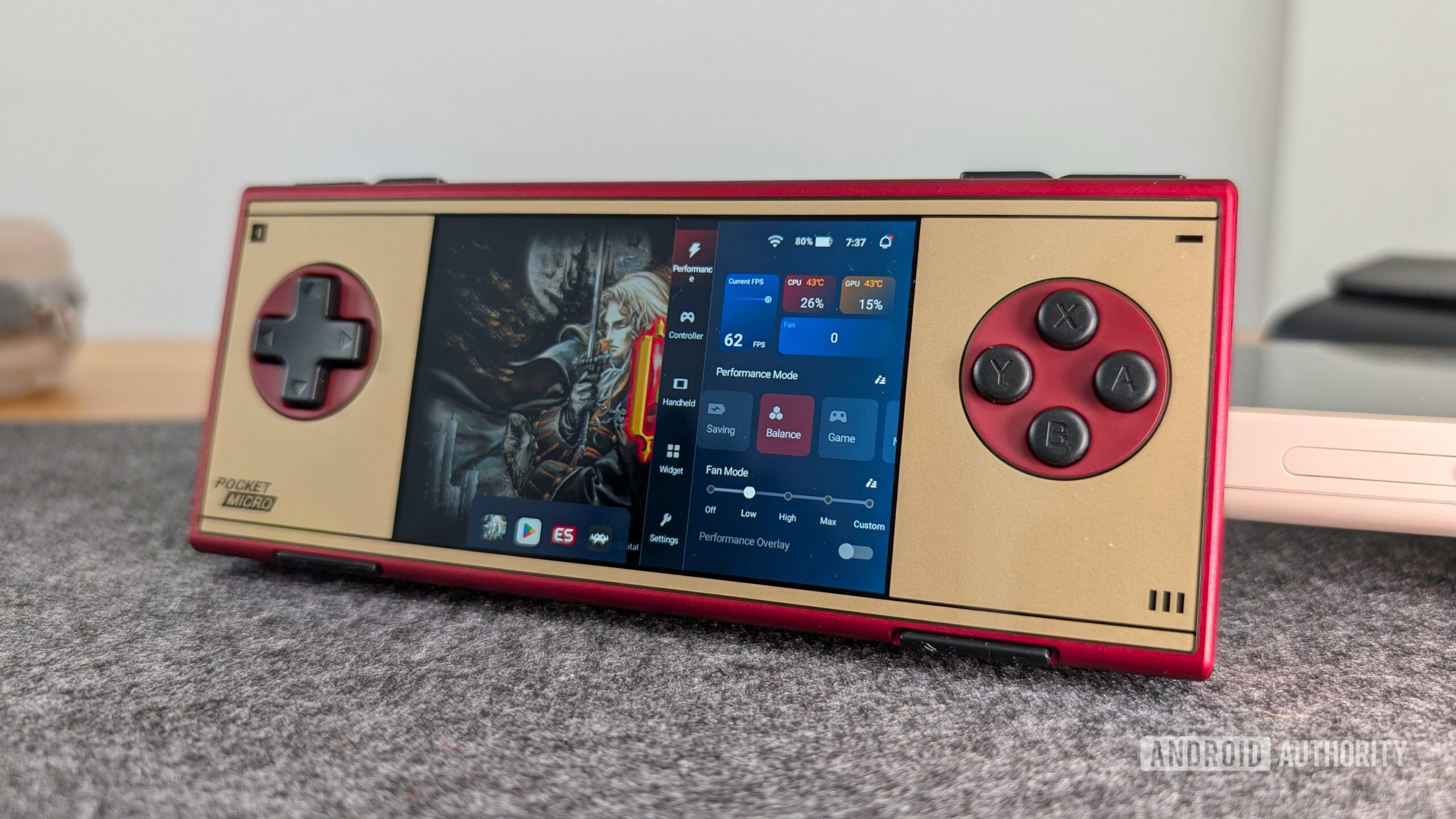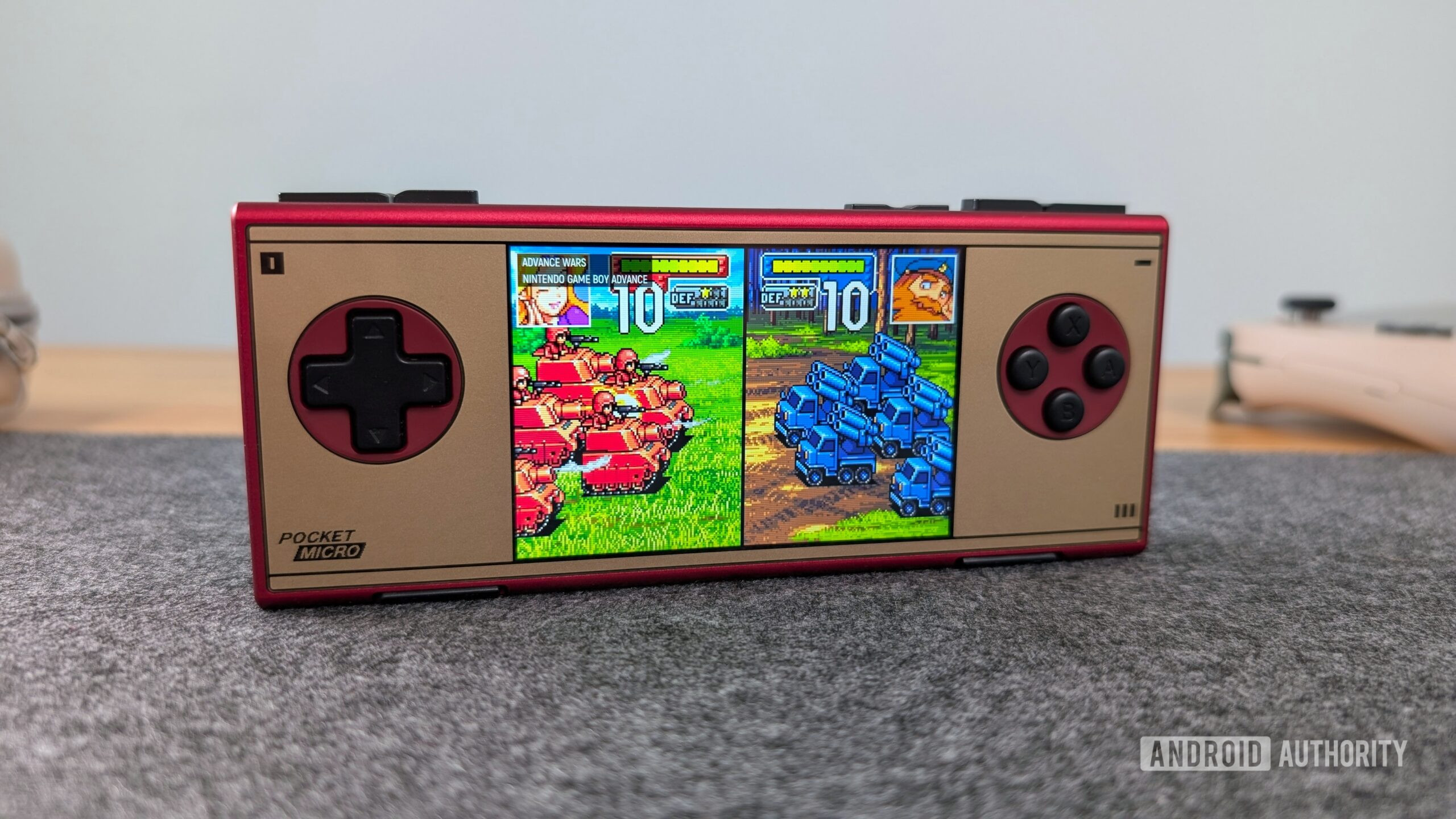
AYANEO Pocket Micro Classic
The AYANEO Pocket Micro Classic is the perfect handheld for 4x upscaled GBA, with enough power for demanding shaders. The high price tag means it’s only really for dedicated collectors, but this is the best a modern Game Boy Micro could be.
While the SNES was the home console that best encapsulates my childhood, the Game Boy Advance was the handheld that really kicked off my gaming addiction. It was revolutionary for teenage me, and I ended up with two standard versions and a GBA SP when it launched a few years later.
But the final iteration, the Game Boy Micro, just never got my attention. By that point, I had graduated to the Nintendo DS (which also played GBA cartridges), so it just never made sense to me.
So when AYANEO sent over the Pocket Micro Classic for review, I didn’t have the rose-tinted nostalgia glasses I would have with something like the Pocket DMG. But after using it for a few weeks, it quickly became my favorite way to play GBA games and more.
A modern Game Boy Micro
Before we get too into the details, I need to point out that this is the second version of the AYANEO Pocket Micro. The original had two small sticks on the front, while the Classic removes them. Otherwise, they’re identical. Personally, I never thought the sticks on the first model made sense, especially for GBA emulation. This design is sleeker, more pocketable, and less prone to accidental inputs than the original.
Regardless, the device is clearly inspired by the Game Boy Micro. It has a long, candy bar shape with a premium metal body and large shoulder buttons. However, the Pocket Micro Classic is much bigger and heavier at 227g. Personally, I think it has a nice heft to it, and the bigger size makes it more comfortable to hold. It’s still pocketable, although I’d definitely get a case to keep it safe.

Nick Fernandez / Android Authority
There are three colorways available, and I was able to test the two premium options, Retro Gray and Retro Gold. Both are absolutely gorgeous. The metal body looks and feels incredible in hand, with a full glass front that blends everything together seamlessly. The back of the device is still a plastic panel, but the rest is pure premium goodness. For my taste, the Famicom-style Retro Gold is the way to go, and I love how the screen bezels blend into the design on the front.
In terms of controls, the D-pad and buttons are fairly soft, but give enough resistance to provide a nice tactile feel. The larger shoulder buttons are a nice touch, although the L2 and R2 buttons aren’t used for the consoles this device is best suited for. Still, they’re perfect for rebinding to hotkeys like save states or fast forward. There are two more buttons on the right-hand side for more hotkeys, with a pre-programmed shortcut to swap the D-pad input to the left joystick to emulate consoles like the N64.

Nick Fernandez / Android Authority
My only complaint about the design of the device is the placement of the start and select buttons. They are located in the chamfer beneath the D-pad. There are two identical buttons on the other side, beneath the buttons, and more than once I hit them instead of start. One of those opens the AYA Window for quick customizations, and the other takes you to the home screen. Unfortunately, the latter closed my emulator, costing me unsaved progress.
The Pocket Micro Classic is the endgame GBA handheld.
I’ve been a fan of the AYA Window on previous AYANEO devices, and it’s great here, too. You can adjust not only controller and performance settings, but also things like brightness and volume. It’s much more convenient than pulling down the Android notification shade. The same can’t be said for the AYASpace app, which serves as a kind of front-end for emulators. I like to use the same setup across different devices, so I stuck with ES-DE.

Nick Fernandez / Android Authority
But the highlight of the device is easily the 3.5-inch IPS display. It might not be OLED, but the 3:2 panel is the perfect resolution for 4x upscaled GBA games. I have to say, it looks absolutely gorgeous. You won’t find a screen or device that’s better suited to GBA emulation. If you’re like me and you are at the stage where you use different device for different systems, this is the endgame GBA retro handheld.
Overkill performance

Nick Fernandez / Android Authority
AYANEO has a nasty habit of packing its handhelds with far more power than they need, and the Pocket Micro Classic is no exception. The Helio G99 is a very capable SoC that’s even able to emulate some PS2 titles. Of course, without sticks, few PS2 games will be enjoyable on this device.
That’s the case with most newer consoles, unfortunately. Although the chipset could comfortably emulate some N64 and Gamecube, I wouldn’t recommend it. The same is true for PSP games, but for a different reason: the screen’s 3:2 aspect ratio leads to large black bars on 16:9 games. They’re playable, but not optimal.
However, that power does come in handy for other kinds of games. Unlike most GBA-focused handhelds, the AYANEO Pocket Micro Classic runs on Android 13 rather than Linux. I tested a lot of controller-compatible Android games, from TMNT: Shredder’s Revenge to Super Meat Boy, and it was an absolute pleasure. Most of these games are more flexible when it comes to adapting to different display sizes, so the black bars are kept to a minimum.

Nick Fernandez / Android Authority
I got five to six hours of game time on Balance mode at full brightness out of the 2,600mAh battery, which is less than I was hoping. It’s not terrible, but AYANEO could have packed a bigger cell into the Pocket Micro Classic. It’s nearly the size of a small smartphone, and we just saw the Pixel 9a launch with a massive 5,100mAh cell. You can push the battery further with lower power profiles or older retro consoles like the SNES, but a battery this small can only be pushed so far.
I was also confused by the fan curves. No matter how hard I pushed it, the fan remained absolutely silent. A representative from AYANEO told me that the fan kicks in above 40 degrees, but if it was turning on, it was remarkably quiet. Thankfully, all the heat buildup is centered around the middle of the device beneath the screen, so the soft metal finish never even felt warm in my hands.
The Pocket Micro Classic’s extra power is great for running demanding shaders for authentic retro vibes.
This chip is unable to handle more demanding games like Genshin Impact, as it is designed more for gaming efficiency than raw performance. In other words, it’s overkill for the GBA games it was designed for but it doesn’t match up to something like the Snapdragon 865 on the Retroid Pocket 5, let alone more recent Snapdragon chips on other AYANEO devices.
The small amount of extra power does come in handy for one thing, and that’s shaders. Shaders are very CPU heavy, and they can bring most budget GBA-focused handhelds to their knee. This device had no problem running several heavy shader passes on the mGBA core in RetroArch, and it can really transform the experience for discerning gamers looking for a more authentic experience on modern hardware.
AYANEO Pocket Micro Classic review verdict: A true collector’s device

Nick Fernandez / Android Authority
And that’s really the rub: this is a device for discerning gamers, not the general public. It’s not cheap, starting at $179 and topping off at $239. For that much money, you can get a more general-purpose device like the Retroid Pocket 5 or Flip 2, which can emulate more systems in a form factor that’s much more friendly to more modern consoles.
But if you already have a more general-purpose gaming handheld and want a more premium experience, the AYANEO Pocket Micro Classic is a great introduction. Once you understand the magic of pixel-perfect 4x GBA upscaling with the right shaders applied, it can be hard to go back.
This shouldn’t be your first emulation device for GBA games, but it might be your last.
Despite the price, it’s still the cheapest device in AYANEO’s Remake collection of retro-style handhelds. I wouldn’t recommend it as your first emulation device, but it could very well be your last, at least when it comes to GBA emulation.
And for me, that’s exactly what I want to use it for. The catalog of GBA games is incredible, with many of my favorite childhood-defining games like Advance Wars, Golden Sun, Pokemon Pinball, Metroid Zero Mission, and more. There’s also a vibrant ROM hacking community, and I definitely whittled away a full afternoon playing Super Mariomon on the Pocket Micro Classic.
The novel Game Boy Micro form factor didn’t win me over back in 2005, but twenty years later, I’m fully on board.


AYANEO Pocket Micro Classic
Beautiful retro design • Perfect 4x GBA scaling • Extra power for shaders
MSRP: $179.00
A modern Game Boy Micro.
The AYANEO Pocket Micro Classic is a GBA-focused handheld, powered by Android and inspired by the Game Boy Micro.
Positives
- Beautiful retro design
- Perfect 4x GBA scaling
- Extra power for shaders
- Useful built-in software suite
Cons
- Expensive
- Not ideal for newer consoles
- Middling battery life











